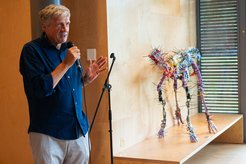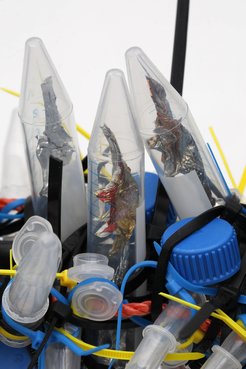Plateosaurus Max – An Artwork for Science
Julia Krause-Harder from Atelier Goldstein crafts a dinosaur sculpture from materials from the Max Planck Institute of Biophysics exhibited in its Café Max
The Frankfurt-based artist Julia Krause-Harder from Atelier Goldstein created a sculpture of a young Plateosaurus for the Max Planck Institute of Biophysics. The dinosaur is crafted from plastic laboratory materials and disused copper cables from the research institute. In September 2023, the artwork was permanently exhibited in the institute’s cafeteria. On the occasion of the upcoming retirement of Werner Kühlbrandt, director of the Department of Structural Biology and initiator of the project, the sculpture was officially inaugurated. Guests learned about Julia Krause-Harder's inspiration and the artwork’s connection to the Institute and its biophysical research.
Text: Katharina Kaefer

About a year ago, the new Café Max at the Max Planck Institute (MPI) of Biophysics in Frankfurt am Main was re-opened after being completely remodelled to the design of interior architect Beate Weller. Weller also came up with the idea to enliven the Café with a sculpture by Julia Krause-Harder from Atelier Goldstein. ‘A communal space like this should foster the members' identification with their institute’, says the designer, ‘This always succeeds when art has a presence.’
Julia Krause-Harder works at Atelier Goldstein in Frankfurt-Sachsenhausen, which supports uniquely talented artists who would otherwise find it difficult to find an audience. Her works are exhibited internationally and are part of renowned collections in Germany, e.g. in the Lenbachhaus in Munich, the Bundeskunstsammlung in Bonn, and around the world. Krause-Harder's art is characterised by a deep fascination for palaeontology and geography. Her declared goal is the sculptural representation of all dinosaur species known to date – according to the artist, more than a thousand. From all sorts of objects such as cassettes, toys and office supplies, or from metal, wood and various plastic materials, she creates anatomically precise, life-size models of the primeval animals.
After initial scepticism – what does a dinosaur have to do with a biophysics research institute? – interior designer Beate Weller found an enthusiastic supporter for her idea in Director Werner Kühlbrandt, who is an art enthusiast himself. The dinosaur became a recycling project, built from disused copper cables and laboratory plastic supplies – art made of the institute's waste products, sustainable, unique, authentic. Julia Krause-Harder decided to create a young Plateosaurus with an overall length of 2.6 m. The bones of the herbivore, which is one of the oldest species ever found in Germany, were discovered mainly in the southern parts of the county.

Last Friday, the colourful, anatomically correct sculpture of the Plateosaurus skeleton was inaugurated at the MPI of Biophysics. Among the guests were many of the institute members, the artist Julia Krause-Harder and her parents, the director of Atelier Goldstein Sophia Edschmid, interior designer Beate Weller and Werner Kühlbrandt with his wife Hester Robinson, who came up with the idea of crafting the sculpture from materials from the institute.

Julia Krause-Harder's Plateosaurus is Kühlbrandt's gift to the institute on the occasion of his retirement at the end of 2023. He named it Max – after Max Planck, the famous scientist who gave his name to the Max Planck Society. On a wooden platform, Julia Krause-Harder’s artwork is permanently exhibited at the MPI of Biophysics. ‘This is Dino Max’, Werner Kühlbrandt introduces the sculpture at the inauguration, ‘And he is standing on a plank: “Max on the Plan(c)k” so to speak!‘ – Laughter from the audience about this creative idea. Even though the dinosaur's deeper connection with molecular biophysics may not be obvious at first glance, Kühlbrandt emphasises it clearly ‘This Plateosaurus functioned millions of years ago according to the same fundamental principles as you and I do today. This is what biophysics has taught us. The structures of, for instance, macromolecular complexes, mitochondria and nuclear pores we explore here today were essentially the same as those of the dinosaur millions of years ago.’ Some details of the artwork that can only be discovered by close observation build a further bridge to basic biomedical research. Julia Krause-Harder laboriously modelled tiny replicas of dinosaurs from candy wrappers and placed them in the plastic tubes that she incorporated into the reptile's skeleton. Werner Kühlbrandt highlights the analogy to the stem cells of living creatures: ‘From each of these mini-dinosaurs a complete Plateosaurus might be regenerated.’

In an interview with Sophia Edschmid, the artist explains what excited her about this work and about the species Plateosaurus. Julia Krause-Harder dedicated more than two months to the project and was very happy to reduce the institute’s collection of disused materials with her artwork. And why did she choose a Plateosaurus? ‘About 220 million years ago, this particular species could have lived right here, where this cafeteria is located now. This was the time when the primeval continent Pangea still existed‘, the artist explains, ‘Here was the periphery of the huge land mass, next to the coast: a zone favouring life.’ Julia Krause-Harder is also fascinated by the time dimension of the era of the dinosaurs which defeats our imagination. ‘Humanity is just a tiny little window, a small light in the history of our earth. The dinosaurs ruled the earth for 180 million years, humans are nothing compared to that. This is sometimes worth remembering when it comes to how we treat our planet.’
Further reading (in German):
Atelier Goldstein: https://www.atelier-goldstein.de/
Julia Krause-Harder: https://www.atelier-goldstein.de/kuenstler/julia-krause-harder/
Architect Beate Weller: https://www.buero-weller.de/










